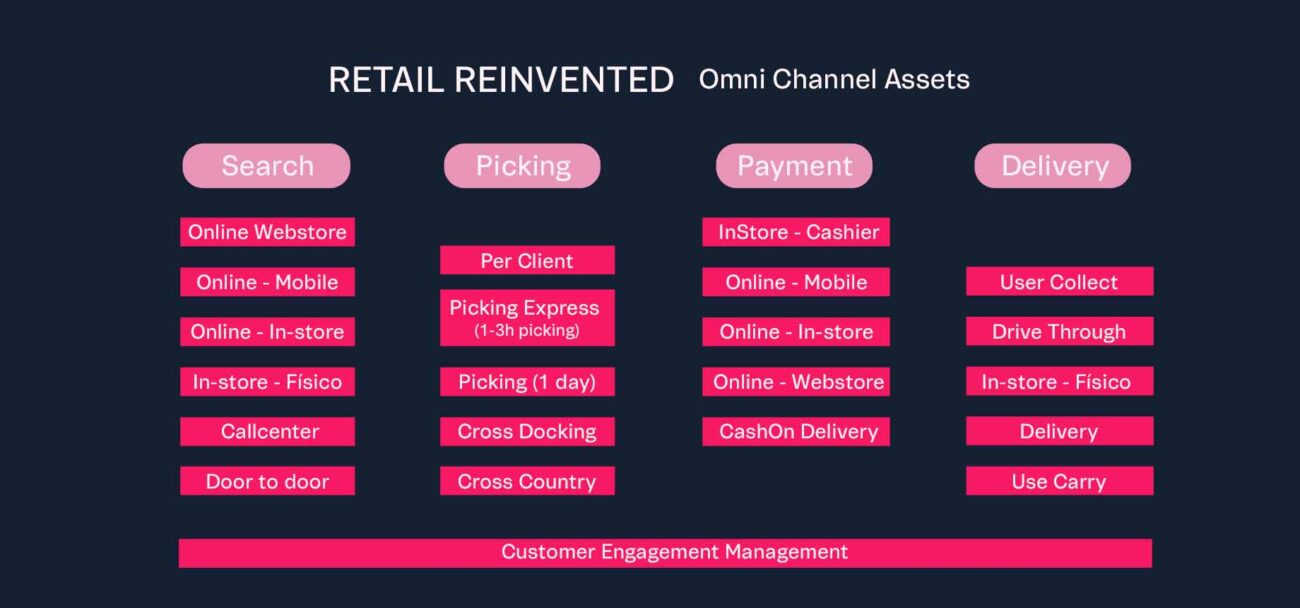
Following on from Part 1 of this blog series on how to build your grocery ecommerce team, I am back with Part 2, this time focusing on team dependencies and possible chains of command.
Who the ecommerce department depends on will impact the team’s approach, capabilities and KPIs, not to mention its independence. Ultimately, it will reflect the company’s position on the importance it gives to the digital commerce strategy and also affect online grocery sales.
Below, you can find some of the most common takes on where to place the ecommerce team inside an organizational structure.
Under the CTO
In many companies, including the grocery segment, ecommerce is given a technological strategy, and therefore depends on the Chief Technology Officer (CTO). Those cases often have in-house developer teams, with KPIs depending more on the website or app uptime, support SLA, site performance and security and data privacy. They serve other areas, especially the commercial and marketing teams.
This type of structure is usually common in traditional companies and it doesn’t reflect a high level of company integration, since alignment with the business areas is often difficult — unless the company has an open “technology as value proposal” vision, and the CTO has a lot of influence on the key strategic decisions.

Under the Commercial Director or Marketing Director
This is the most common organizational structure you can find in LATAM and potentially worldwide. In this model, the Ecommerce area answers to the Commercial Director (especially in B2B business models) or the Marketing Director (typical in more B2C-focused companies), depending on which area has more weight.
This blueprint is driven by time-to-market, focused on ROI and fast growth and it sometimes helps to align ecommerce with the “offline” sales strategy. Still, cross-area alignment is usually painful, and the project’s success and area’s growth depend more on the individual capability and vision of the Director, and not on the company itself.
Under an independent Director that responds directly to the CEO
Going down this route reflects a more strategic approach to Digital Commerce, with a Chief Digital Officer (CDO) or Director of Ecommerce taking the helm of the ecommerce business. A direct line to the CEO or General Manager gives the person in charge more autonomy, weight on the board and much more investment to build large teams, manage vendors and budgets — all in an integrated way.
The only problem here is that many roles (e.g. marketing, commercial or operations) are duplicated, having both a Digital Marketing and pure Marketing team. Also, as it views each area as a different channel, it is therefore a big challenge to align internally.
Under an Omnichannel Director
This structure type is very similar to the previous one, only that it takes it a little bit further. With an Omnichannel Director that starts to integrate the brick-and-mortar and digital channels and is responsible for both worlds, a digital transformation project might prove faster to achieve since they would be looking for logics that can create symbiotic approaches to grocery sales.

The cross-area approach
Another interesting strategy used by some companies is having a matrix approach to the creation and subsequent structure of the ecommerce team. In a nutshell, the usual organizational structure remains the same, but each area has a digital mirror inside it (e.g. Marketing has a Digital Marketing collaborator).
These collaborators have a double dependency, answering both to the area manager as well as to their Ecommerce/Digital Head. This is yet another method that serves other areas, but it has the advantage of a 360-degree view on the entire organizational machine. On the negative side, however, the double management that results from this matrix organization is difficult to deal with on a daily basis and can heavily delay decision-making.
A structure that doesn’t yet exist
It might sound a little far fetched, given the stated importance of having a strategic approach to Digital Commerce. Still an “ecommerce/digital commerce” approach implies by definition a channels perspective, being ecommerce the selling through a digital medium, generally a website or app (one could argue that digital commerce has a broader meaning).
But the practical execution of an omnichannel strategy that many companies pursue, where the customer is at the center of it all, showed us that our customers don’t perceive any channel at all. It’s all just one brand, one perceived value and one cumuli of experiences they had with the grocery retailer. Therefore, channels have no meaning or importance for the end-customers, and therefore should not have for you as a company.
That’s why the Unified Commerce approach stops addressing channels as more or less integrated boxes, but rather as points of contact in a single system, with the customer always front and center. Following that idea, all the company areas and members should be natively digital, therefore triggering a full restructuring of all areas and processes of the company, on top of training.
Without a doubt, this model is very difficult to practice. In theory, however, following it would eliminate any channel friction a client may receive and lead to more team efficiency, as it takes out any role duplication across different sales channels. Ultimately, it makes it purposeless to have a channel-specific team/area, not even one just for ecommerce.
The EICOM Institute made an organizational chart of the unified commerce company, and it resembles something like this:

Team fluctuation and retention
Maintaining a team of goal-oriented, highly-driven, knowledge-thirsty high-performers is not an easy task, but it is crucial to succeeding in the digital commerce world. The talent and specific-knowledge shortage has proven to be so strong, that there have been massive sector changes due to this very factor.
A very clear example of this phenomenon is how this high demand impacts more expensive and higher-margin companies, driving entities to “steal” personnel from one another, leaving retailers with a very small capacity to retain their senior collaborators and top performers.
This has led to an increase in outsourcing those roles and a jump in SaaS popularity. So, whether you have an internal team or outsource a service, it is important when thinking about team retention to plan for the worst possible scenario. Imagine your Ecommerce Director or Marketing Manager leaving the company, what kind of gap would they leave?
It is important to understand that digital commerce is still an empirical science and practice, meaning that much of the knowledge we have is trapped and unstructured in our own little minds. To minimize the impact of knowledge loss inside the company, a strong documentation process should be in place. Whether it’s mapping systems, doing tutorials, having internal wikis or periodic training and testing, the main point is to ensure the knowledge transmission from one to many and easy access to processed and structured information.
Having solved that, we still need to address the retention problem itself. Competitive incentive programs, strong career pathways and a healthy work environment are just some of the many things a company and its leaders could do in order to lower employee turnover.
And, last but not least, not all rotation is bad. Some of the team’s fluctuation is due to temporary demand, especially the Operations team on massive events like Black Friday or Cyber Monday, in which orders can multiply 10 times. In those cases, there needs to be a good and fast hiring process, accompanied by a fast and efficient onboarding in order to upscale and downscale the team quickly, without affecting each team’s KPIs and service quality in general.
The right formula
Remember that no matter the organizational structure that envelopes your grocery ecommerce team, there will always be errors to make and lessons to learn. Also, there is room for adjustments mid-way — adapt your strategy to your business’s needs. Part 3 of this series will further help in this regard by offering you details on the different sub-teams, team members, key roles and job descriptions that have a say in grocery ecommerce success. Make sure not to miss it.













